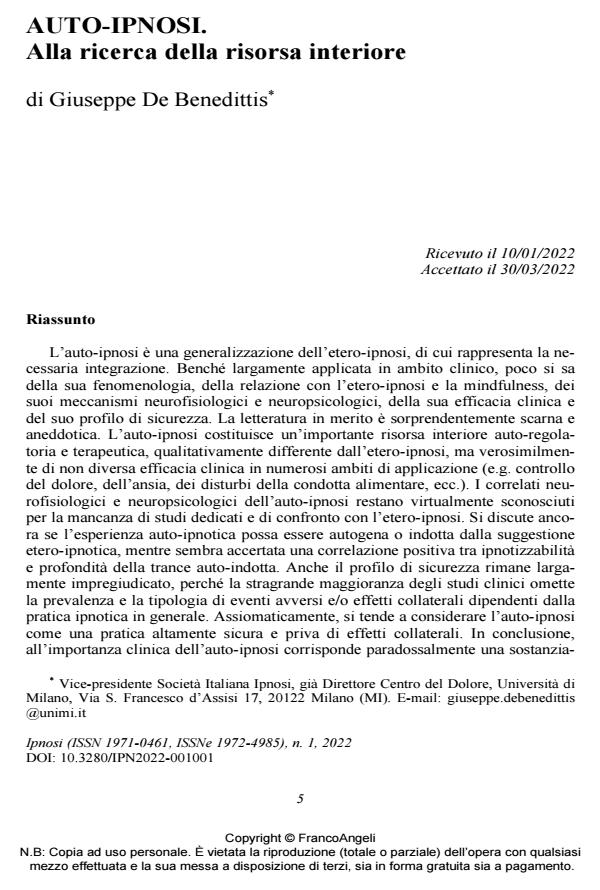Self-Hypnosis: In Search of the Inner Resource
Journal title IPNOSI
Author/s Giuseppe De Benedittis
Publishing Year 2022 Issue 2022/1
Language Italian Pages 16 P. 5-20 File size 194 KB
DOI 10.3280/IPN2022-001001
DOI is like a bar code for intellectual property: to have more infomation
click here
Below, you can see the article first page
If you want to buy this article in PDF format, you can do it, following the instructions to buy download credits

FrancoAngeli is member of Publishers International Linking Association, Inc (PILA), a not-for-profit association which run the CrossRef service enabling links to and from online scholarly content.
Self-hypnosis is a generalization of hetero-hypnosis, of which it represents the necessary integration. Although widely applied in the clinical setting, little is known about its phenomenology, its relationship with hetero-hypnosis and mindfulness, its neurophysiological and neuropsychological mechanisms, its clinical efficacy and its safety profile. The literature on the subject is surprisingly sparse and anecdotal. Self-hypnosis constitutes an important self-regulatory and therapeutic inner resource, qualitatively different from hetero-hypnosis, but probably of no different clinical efficacy in numerous areas of application. The neurophysiological and neuropsychological correlates of self-hypnosis remain virtually unknown due to the lack of dedicated studies and comparison with hetero-hypnosis. It is still debated whether the self-hypnotic experience can be autogenous or induced by hetero-hypnotic suggestion, while a positive correlation between hypnotizability and the depth of the self-induced trance seems to be established. The safety profile also remains largely unknown, because the vast majority of clinical studies omit the prevalence and type of adverse events and / or side effects dependent on hypnotic practice in general. Axiomatically, we tend to consider self-hypnosis as a highly safe practice with virtually no side effects. In conclusion, the clinical importance of self-hypnosis paradoxically corresponds to a substantial lack of clinical-experimental studies. Self-hypnosis is therefore a Terra Incognita that is urgently waiting to be explored.
Keywords: Self-hypnosis, hetero-hypnosis, self-hypnosis mechanisms, mindfulness, technique and clinical efficacy.
- Autoipnosi ericksoniana con uso di toni binaurali e suoni ASMR. Presentazione di un protocollo di somministrazione con case report Claudio Mammini, Nives Manzoni, in IPNOSI 1/2023 pp.23
DOI: 10.3280/IPN2023-001002
Giuseppe De Benedittis, AUTO-IPNOSI. Alla ricerca della risorsa interiore in "IPNOSI" 1/2022, pp 5-20, DOI: 10.3280/IPN2022-001001